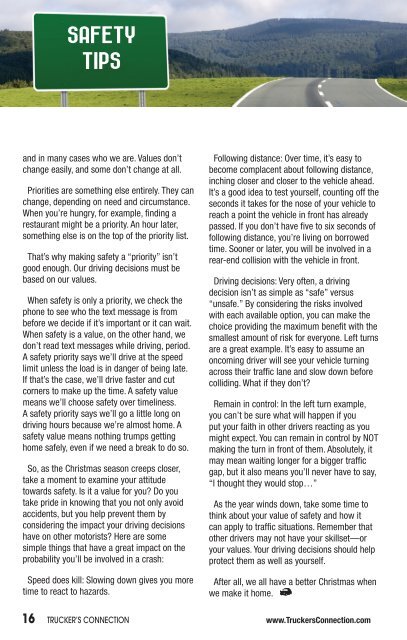Create successful ePaper yourself
Turn your PDF publications into a flip-book with our unique Google optimized e-Paper software.
Safety<br />
Tips<br />
and in many cases who we are. Values don’t<br />
change easily, and some don’t change at all.<br />
Priorities are something else entirely. They can<br />
change, depending on need and circumstance.<br />
When you’re hungry, for example, finding a<br />
restaurant might be a priority. An hour later,<br />
something else is on the top of the priority list.<br />
That’s why making safety a “priority” isn’t<br />
good enough. Our driving decisions must be<br />
based on our values.<br />
When safety is only a priority, we check the<br />
phone to see who the text message is from<br />
before we decide if it’s important or it can wait.<br />
When safety is a value, on the other hand, we<br />
don’t read text messages while driving, period.<br />
A safety priority says we’ll drive at the speed<br />
limit unless the load is in danger of being late.<br />
If that’s the case, we’ll drive faster and cut<br />
corners to make up the time. A safety value<br />
means we’ll choose safety over timeliness.<br />
A safety priority says we’ll go a little long on<br />
driving hours because we’re almost home. A<br />
safety value means nothing trumps getting<br />
home safely, even if we need a break to do so.<br />
So, as the Christmas season creeps closer,<br />
take a moment to examine your attitude<br />
towards safety. Is it a value for you? Do you<br />
take pride in knowing that you not only avoid<br />
accidents, but you help prevent them by<br />
considering the impact your driving decisions<br />
have on other motorists? Here are some<br />
simple things that have a great impact on the<br />
probability you’ll be involved in a crash:<br />
Speed does kill: Slowing down gives you more<br />
time to react to hazards.<br />
Following distance: Over time, it’s easy to<br />
become complacent about following distance,<br />
inching closer and closer to the vehicle ahead.<br />
It’s a good idea to test yourself, counting off the<br />
seconds it takes for the nose of your vehicle to<br />
reach a point the vehicle in front has already<br />
passed. If you don’t have five to six seconds of<br />
following distance, you’re living on borrowed<br />
time. Sooner or later, you will be involved in a<br />
rear-end collision with the vehicle in front.<br />
Driving decisions: Very often, a driving<br />
decision isn’t as simple as “safe” versus<br />
“unsafe.” By considering the risks involved<br />
with each available option, you can make the<br />
choice providing the maximum benefit with the<br />
smallest amount of risk for everyone. Left turns<br />
are a great example. It’s easy to assume an<br />
oncoming driver will see your vehicle turning<br />
across their traffic lane and slow down before<br />
colliding. What if they don’t?<br />
Remain in control: In the left turn example,<br />
you can’t be sure what will happen if you<br />
put your faith in other drivers reacting as you<br />
might expect. You can remain in control by NOT<br />
making the turn in front of them. Absolutely, it<br />
may mean waiting longer for a bigger traffic<br />
gap, but it also means you’ll never have to say,<br />
“I thought they would stop…”<br />
As the year winds down, take some time to<br />
think about your value of safety and how it<br />
can apply to traffic situations. Remember that<br />
other drivers may not have your skillset—or<br />
your values. Your driving decisions should help<br />
protect them as well as yourself.<br />
After all, we all have a better Christmas when<br />
we make it home.<br />
16 TRUCKER’S CONNECTION www.Truckers<strong>Connection</strong>.com

















